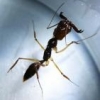- Formiculture.com
- Forums
- Gallery
- Members
- Member Map
- Chat

Queen ant
Started By
OwenH
, Oct 14 2016 4:06 PM
14 replies to this topic
#1
 Offline
-
Posted October 14 2016 - 4:06 PM
Offline
-
Posted October 14 2016 - 4:06 PM
http://imgur.com/echha2t
http://imgur.com/wwrDiRC
http://imgur.com/BhU4FHA
Caught in my backyard in a mossy area.
It looks to be lasius but from what I know, they do not fly around this time?
http://imgur.com/wwrDiRC
http://imgur.com/BhU4FHA
Caught in my backyard in a mossy area.
It looks to be lasius but from what I know, they do not fly around this time?
- Enderz likes this
#2
 Offline
-
Posted October 14 2016 - 4:16 PM
Offline
-
Posted October 14 2016 - 4:16 PM
Yes definitely a queen! But for an ID u will need a location and measurements and a better photo
YJK
#3
 Offline
-
Posted October 14 2016 - 4:22 PM
Offline
-
Posted October 14 2016 - 4:22 PM
There are still some late lasius flyers right now, mainly parasitic species. Lasius cf. umbratus is my guess. Parasitic species need callow workers to be introduced to them to start laying eggs. I suggest you research parasitic queens before attempting to introduce workers.
Edited by Kevin, October 14 2016 - 4:23 PM.
Hit "Like This" if it helped.
#4
 Offline
-
Posted October 14 2016 - 4:33 PM
Offline
-
Posted October 14 2016 - 4:33 PM
Yes definitely a queen! But for an ID u will need a location and measurements and a better photo
She is 7mm long. I caught her in Rocky Mount, NC. I cannot get a better picture of her sadly, my Iphones camera isn't very good.
#5
 Offline
-
Posted October 14 2016 - 4:35 PM
Offline
-
Posted October 14 2016 - 4:35 PM
There are still some late lasius flyers right now, mainly parasitic species. Lasius cf. umbratus is my guess. Parasitic species need callow workers to be introduced to them to start laying eggs. I suggest you research parasitic queens before attempting to introduce workers.
Do the workers have to be of the same species? I would doubt that, if not, what should I introduce her to? I caught three of them two days ago and seem to be doing fine, they spend all of their time grooming themselves or just sitting still.
#6
 Offline
-
Posted October 14 2016 - 4:44 PM
Offline
-
Posted October 14 2016 - 4:44 PM
If you can find newborn lasius workers in general your good to go. The goal of a parasitic queen is to take over an existing nest, therefore you don't need the same species. Start off with 5-10 workers and see if the queen starts to lay.
Hit "Like This" if it helped.
#7
 Offline
-
Posted October 14 2016 - 4:59 PM
Offline
-
Posted October 14 2016 - 4:59 PM
If you can find newborn lasius workers in general your good to go. The goal of a parasitic queen is to take over an existing nest, therefore you don't need the same species. Start off with 5-10 workers and see if the queen starts to lay.
Okay, hopefully tomorrow I will find some new workers to introduce them to.
#8
 Offline
-
Posted October 14 2016 - 5:56 PM
Offline
-
Posted October 14 2016 - 5:56 PM
If you can find newborn lasius workers in general your good to go. The goal of a parasitic queen is to take over an existing nest, therefore you don't need the same species. Start off with 5-10 workers and see if the queen starts to lay.
Okay, hopefully tomorrow I will find some new workers to introduce them to.
They NEED to be callow workers, regular workers will attack and kill the queen. I doubt this time of year you'll be able to find callow lasius workers. I would put these queens in hibernation as their fat won't last them very long.
Edited by Mdrogun, October 14 2016 - 5:56 PM.
Currently Keeping:
Trachymyrmex septentrionalis
Pheidole pilifera
Forelius sp. (Monogynous, bicolored) "Midwestern Forelius"
Crematogaster cerasi
Pheidole bicarinata
Aphaenogaster rudis
Camponotus chromaiodes
Formica sp. (microgena species)
Nylanderia cf. arenivega
#9
 Offline
-
Posted October 14 2016 - 7:58 PM
Offline
-
Posted October 14 2016 - 7:58 PM
Callow workers are just a sure thing for adoption. You can use younger adult workers, although there may be some conflict. Two of my current social parasite queens were introduced this way.
If you've enjoyed using my expertise and identifications, please do not create undue ecological risk by releasing your ants. The environment which we keep our pet insects is alien and oftentimes unsanitary, so ensure that wild populations stay safe by giving your ants the best care you can manage for the rest of their lives, as we must do with any other pet.
Exotic ants are for those who think that vibrant diversity is something you need to pay money to see. It is illegal to transport live ants across state lines.
----
Black lives still matter.
#10
 Offline
-
Posted October 14 2016 - 8:33 PM
Offline
-
Posted October 14 2016 - 8:33 PM
As Batspiderfish said, you can potentially use adults, there's just some risk of, well, catastrophic failure.
After reading where someone introduced a queen to a colony whose queen had passed, I stole a dozen or so Lasius claviger workers from a colony in my backyard last month. There were isolated, each in her own test tube, for about half a week, then introduced one by one every few hours to what I believe is a captive Lasius claviger queen I found elsewhere. (FYI, they're not joking when they say Lasius need high humidity. Lost half the workers figuring that out.) There was a little bit of panic at first, but no violence. I collected more, and repeated the process, and currently she has about 35-40 workers and no brood all from the same colony.
I haven't observed trophallaxis yet, but I have observed grooming and attempts at communication. The queen seems relatively indifferent toward the workers' attention, sadly, so I'm not sure how this will pan out long term.
#11
 Offline
-
Posted October 14 2016 - 8:45 PM
Offline
-
Posted October 14 2016 - 8:45 PM
Lasius don't need exceptional humidity. I imagine the deaths might have been caused by their isolation.
If you've enjoyed using my expertise and identifications, please do not create undue ecological risk by releasing your ants. The environment which we keep our pet insects is alien and oftentimes unsanitary, so ensure that wild populations stay safe by giving your ants the best care you can manage for the rest of their lives, as we must do with any other pet.
Exotic ants are for those who think that vibrant diversity is something you need to pay money to see. It is illegal to transport live ants across state lines.
----
Black lives still matter.
#12
 Offline
-
Posted October 15 2016 - 6:39 AM
Offline
-
Posted October 15 2016 - 6:39 AM
As Batspiderfish said, you can potentially use adults, there's just some risk of, well, catastrophic failure.
After reading where someone introduced a queen to a colony whose queen had passed, I stole a dozen or so Lasius claviger workers from a colony in my backyard last month. There were isolated, each in her own test tube, for about half a week, then introduced one by one every few hours to what I believe is a captive Lasius claviger queen I found elsewhere. (FYI, they're not joking when they say Lasius need high humidity. Lost half the workers figuring that out.) There was a little bit of panic at first, but no violence. I collected more, and repeated the process, and currently she has about 35-40 workers and no brood all from the same colony.
I haven't observed trophallaxis yet, but I have observed grooming and attempts at communication. The queen seems relatively indifferent toward the workers' attention, sadly, so I'm not sure how this will pan out long term.
I have three of these queens so hopefully out of the three tries it works.
#13
 Offline
-
Posted October 15 2016 - 9:30 PM
Offline
-
Posted October 15 2016 - 9:30 PM
Good luck, If they don't survive don"t feel too bad it's not always easy to do this ![]()
![]()
![]()
![]()
![]()
Ex igne et in infernum.
#14
 Offline
-
Posted October 16 2016 - 1:13 PM
Offline
-
Posted October 16 2016 - 1:13 PM
I caught lasius workers from a nest and found the ones closest to the brood. I have placed the queen and the 7 workers in the setup in the picture, workers walk in and out and don't pay any mind to the queen and she doesn't pay attention to them. So far so good.
http://imgur.com/9Aye6Xs
http://imgur.com/9Aye6Xs
#15
 Offline
-
Posted October 16 2016 - 1:30 PM
Offline
-
Posted October 16 2016 - 1:30 PM
I found that the best way is to introduce them one by one so I moved one to a test tube with the queen and they seem to accept each other .
0 user(s) are reading this topic
0 members, 0 guests, 0 anonymous users

















